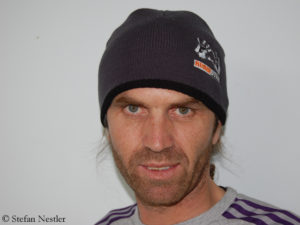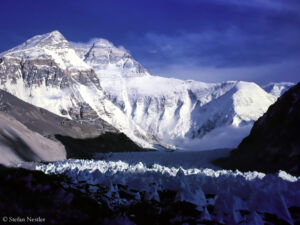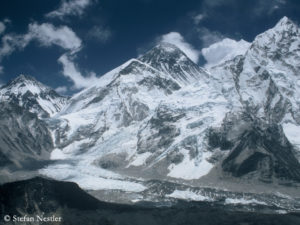When Thomas Huber talks about freedom in the mountains, his eyes light up. “Mountains are so much more than just a name, an ascent or a record,” the older of the two Huber brothers tells me. “Mountains give you...
When Thomas Huber talks about freedom in the mountains, his eyes light up. “Mountains are so much more than just a name, an ascent or a record,” the older of the two Huber brothers tells me. “Mountains give you the opportunity to find something very special. Within yourself. Your inner freedom.” Thomas is now 57 years old. After losing his hunting dog Cerro, who was run over last winter, he decided to give up expeditions this year. Instead, he concentrated on training his new dog Torre – and returning to his mountaineering roots: extreme climbing.
Masterpiece
“Last spring, the eighth degree of difficulty was the status quo for me,” Huber tells me before a lecture last weekend in Cologne. “I weighed 88 kilograms, I had a small potbelly. So I said to myself: Cerro, you’re now giving me this challenge to come back.” He looked for a project on his doorstep: the new “Meisterstückl (Masterpiece)” route on the 1,973-metre-high Untersberg near Berchtesgaden in the Bavarian Alps, “something between the upper tenth and lower eleventh degree of difficulty”.
He and his brother Alexander became famous worldwide with routes at this extreme level – when they were much younger. “Someone like (30-year-old German top climber) Alex Megos eats a few carrots and then does a route like this as a warm-up,” says Thomas and laughs. “I was already very far away from that and thought I would only do expeditions where experience is the most important thing. I trained very hard. And now I’m back.”
At the end of October, on one of the last beautiful fall days, he was on the verge of completing the route. “I could have done it that day. The conditions were perfect, the rock had great grip,” says Huber. Then a boulder broke off and slightly injured his left ankle. Because he could no longer put full weight on his foot, he was unable to continue climbing. “But now I’m feeling great again. Then I’ll just do it next year. The mountain won’t run away.”
Shivling, Latok, Ogre
In his career, Thomas Huber has not only made mountaineering history in the Alps, but also on the granite rocks of Yosemite National Park, in Patagonia, Antarctica, the Indian Himalayas and the Karakoram. The list of his first ascents is long. In 1997, together with his brother Alexander, Toni Gutsch and Conrad Anker, he climbed the West Face of the 7,108-meter-high Latok II in Pakistan for the first time. In 2001, he and Iwan Wolf mastered a new route on the North Pillar of the 6,543-meter-high Shivling in India. For this, they were awarded the Piolet d’Or, the “Oscar of Climbing”. In 2001, Huber – together with Wolf and Urs Stoecker – made the only second ascent of the legendary 7,285-meter-high Ogre in Pakistan, which is considered one of the most difficult and dangerous mountains in the world.
“A real mountaineer would never do that”
Thomas just shakes his head at the commercial mountaineering on eight-thousanders. “It has nothing to do with normal mountaineering anymore, it’s just mountain tourism,” says Huber. “The Sherpas have discovered eight-thousander mountaineering as a business model. They are not only on the move in their own country, but also in Pakistan and India, where they fix the ropes. There’s no question about it, they’re top-notch and know how to do it. But the fixed ropes are now used from base camp to the summit.”
The death of the Pakistani high altitude porter Muhammad Hassan on K2 last summer and the fact that dozens of summit aspirants climbed past him shook Huber. “A real mountaineer would never do something like that,” says Thomas. “I wouldn’t have gone any further, even if he had died. Whenever something happened on our expeditions, which were far more difficult than climbing K2 on the normal route, we put everything else on the back burner – regardless of whether Russians, Ukrainians, Americans or anyone else was involved. A person’s life counts, and the mountain can wait.”
Understanding the mountain
What happened on K2 is also happening on other attractive eight-thousanders such as Manaslu, Kangchenjunga and, above all, Mount Everest, says Huber. “I just don’t feel like doing that anymore. I don’t need an eight-thousander.” These mountains are simply too crowded for him, the environmental pollution is frightening. And the attitude of most people there is also completely different to his own.
“There is the wonderful saying by Paul Preuss: ‘The ability is the measure of what you are allowed to do.’ But he forgot one aspect: At the end of the day, the mountain dictates how far you can go. You have to understand the language of nature and the mountains. That’s the only way you can survive in extreme situations,” says Thomas. “Eight-thousander climbers who have only trained once with crampons and only just know how to attach themselves to the fixed rope with the Jumar (ascender) have not understood the mountain. They see it purely as a trophy.”
Return to Choktoi Valley
Next year, Thomas Huber wants to go on expedition again, to Patagonia – and once more to the valley of the Choktoi Glacier in the Karakoram, with its granite giants such as the Latok peaks. “If we’re lucky, the conditions are right and we’re healthy, we can achieve something,” says Thomas, quoting the US climber Dean Potter, who died in a wingsuit accident in 2015: “Mountaineering is not an extreme sport, it’s an art. A special confrontation with nature. Art is boundless and dissolves all boundaries. And that gives you personal freedom.” And his eyes light up again.
Der Beitrag Thomas Huber: “I don’t need an eight-thousander” erschien zuerst auf Adventure Mountain.



















